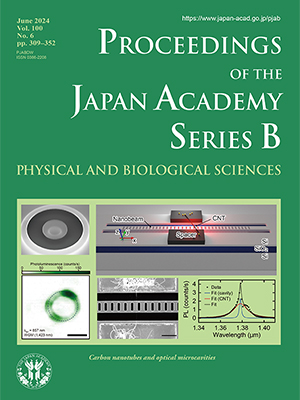About the Cover
Vol. 100 No. 6 (2024)
The integration of carbon nanotubes (CNTs) into silicon photonics is advantageous for expanding the functionality of state-of-the-art photonic integrated circuits. CNTs can be directly synthesized on silicon and show bright emission in the telecom bands, in which silicon is transparent. Electrically controlled CNT devices efficiently detect and generate photons. Excitons in CNTs generate telecom-band single photons at room temperature, thereby opening a promising pathway for practical integrated quantum photonics based on discrete variables. To further leverage the unique CNT characteristics, coupling them to photonic nanostructures is essential. Optical microcavities are of particular interest because of the considerable enhancement of light-matter interactions.
Review article by Terashima et al. in this issue (pp. 320–334) discusses optical coupling of individual air-suspended CNTs to silicon-based optical microcavities and the invoked cavity quantum electrodynamical phenomena. The authors discuss certain CNT types coupled to several different optical microcavities, including microdisk resonators and air-mode photonic crystal nanobeam cavities. Notably, the strong Purcell effect in single CNTs leads to near unity quantum efficiency of bright excitons at room temperature.
The top-left panel shows a scanning electron microscope image of a silicon microdisk resonator that supports high Q-factor whispering-gallery modes. Optical coupling with the whispering-gallery mode of CNTs is visualized through spectrally-resolved photoluminescence imaging (bottom left). The nanotube emission coupled to the resonator mode circulates within the disk.
The top-right panel shows a schematic of an air-suspended CNT coupled to an air-mode photonic crystal nanobeam cavity. The cavity mode is carefully designed; thus, their interactions with CNT are enlarged. The bottom middle panel indicates a scanning electron micrograph of a fabricated device. CNT is suspended over the silicon nanobeam. A photoluminescence spectrum from the device demonstrates the enhanced emission from CNT (bottom right).
Yasutomo Ota
Associate Professor, Keio University




